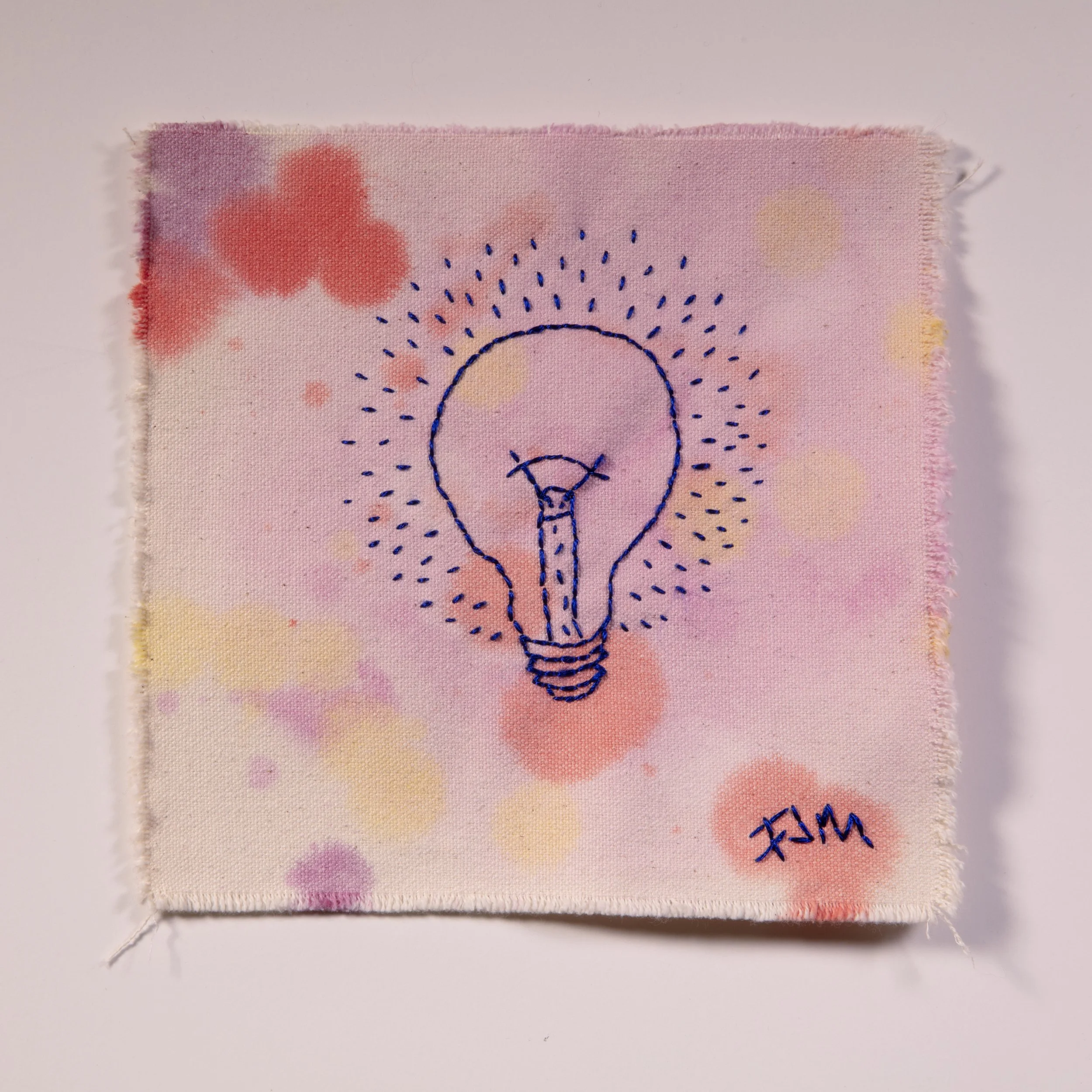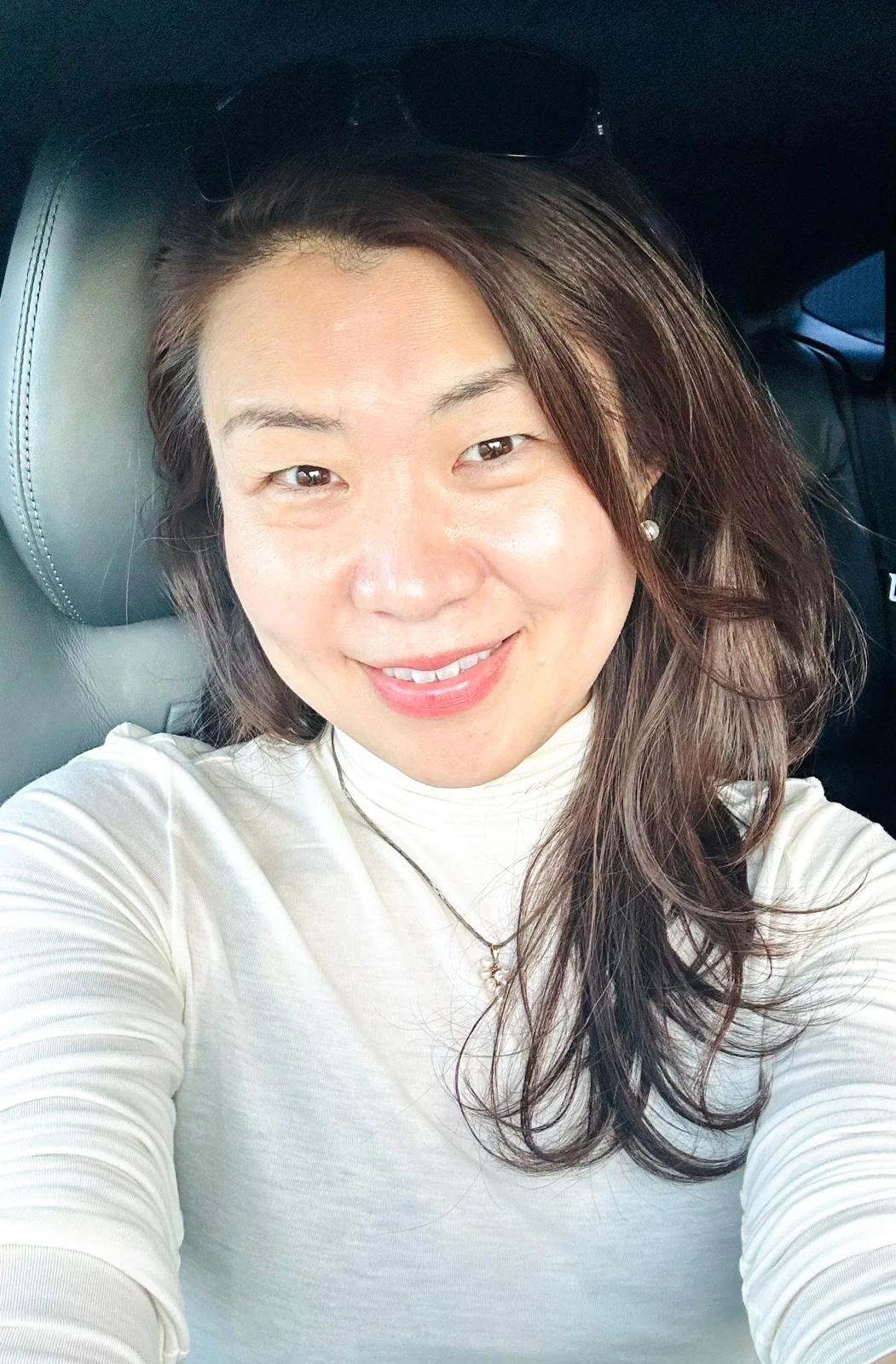EXHIBITION ESSAY/REFLECTIONS
By Madoka Muramatsu
Visible Mending - Reclaiming the Wounds
“I don’t quite know why, but I’ve been drawn to the image of the lightbulb.”
The artist explained, standing before the audience gathered to hear her speak.
Frances Melhop.
For many years, she stood at the forefront of the fashion industry as a photographer for some of the world’s most iconic magazines—Vogue, Elle, Marie Claire, and more—often shaping narrative-rich, ethereal editorials.
Now, she devotes herself to fine art—where her hands return, again and again, to the tactile, the intimate, and the handmade, seeking what was lost in the rise of the digital.
During the gallery talk, Frances spoke about how her years as a fashion photographer continue to shape her work as an artist.
“I’m endlessly fascinated by the human presence that reveals itself through imperfection. That’s where I find beauty. Back when I worked in fashion, if a model had a little gap between her teeth, I’d fall in love with that detail—and that’s when I’d press the shutter.”
The world seen through the camera’s viewfinder and the one traced by hand—her work was born in the layers where those two converged. She breathed and thrived in that in-between.
And now, through her art, it seems to me that she is reclaiming the depth, time, space, and texture that once vanished into the digital.
I had been asked to interpret for the audience at the reception that followed her talk. But just minutes before arriving, I knew almost nothing about Frances or her work. The request came so suddenly—while I was in motion—I barely had time to reply, let alone research.
So there I was, standing among a room full of visitors seeing her work for the first time in Japan, listening to the artist’s voice as one of them.
Her first solo exhibition in Japan held space for both mourning and hope—works that honored lives abruptly taken, and others that offered quiet assurance for lives still unfolding, and those yet to begin. Presented under the title Visible Mending, the exhibition featured pieces meticulously hand-stitched with time, care, and presence—each thread a visible trace of restoration.
“There’s something—though I can’t quite name it—that makes me feel there’s a link between women and lightbulbs,” Frances said.
“Take, for example, Atsuko Tanaka, the Japanese artist who once caught the world’s attention with a dress made entirely of lightbulbs. Or, Ewa Partum who made performances draped solely in electric cable and glowing light bulbs. Or, how, in the past, most of the people who worked in lightbulb factories were women... I can’t explain exactly how these things connect, but I feel it’s significant.”
Standing before a wall of delicately stitched lightbulbs, her voice warmed with intensity.
“I just feel this thread between women and lightbulbs, and I keep stitching them. Maybe it’s the shape, too. It’s round and bulbous—womb-like, in a way. If you flip it upside down, it even resembles a breast.”
“And the light it emits. The idea of a lightbulb being switched on… we use it as a symbol for inspiration, don’t we? I haven’t reached a definitive reason why, but I feel a connection between the image of the lightbulb and the feminine. These works carry that meaning with them.”
I had never once considered a connection between women and lightbulbs.
I'm not particularly well-versed in art, and I didn’t know anything about the lightbulb dress she mentioned. I’d never heard that it was mostly women who made lightbulbs in factories.
But when she spoke about the shape of the lightbulb—how it reminded her of the womb—something inside me stirred.
Faintly, but surely, a lightbulb switched on within me.
I stayed focused on my role as interpreter throughout the event—but later, as I exchanged personal words with the artist, that little light within me began to grow brighter.
Womb. Woman. Feminine. Disappearance. Body. Light...
The words we exchanged seemed to cross paths, uncannily, with the very themes and symbols that had smoldered inside me for years—stubbornly unresolved, now becoming, at last, ready to transform into a new form.
A flash of associations streaked through me.
In Japanese mythology, the sun goddess Amaterasu once hid herself in a cave, plunging the world into darkness.
In yogic tradition, Shakti—the feminine creative force—is seen as the energy that animates life.
“Our femininity,” someone once told me, “is like light. You can cover it, but you cannot extinguish it.”
They flooded back — vivid and radiant — like a reminder of the truth I had always known deep inside.
Light fell once more on memories of old wounds.
Wounds I had washed clean, over and over and over again.
And with the light came a half-forgotten ache.
Slow, steady, and deep in my chest.
The wounds feared being buried for good in the depths of my darkness, unseen and unspoken.
“I was here.”
With the light, the hidden wounds began to take shape.
“I am here.”
“I’m still here.”
“Don’t pretend I never was.”
*********************
A lightbulb holds light.
Not because of its shape,
but because of what it holds within.
That— is why it shines.
*********************
Forgive me
for pretending not to see you.
I’m not making you invisible.
I won’t.
I can’t.
Because you are a part of me.
You struggled hard to bring me here.
You are my tears.
Precious, warm, strong,
and mine.
We each carry a lightbulb.
A sacred vessel, capable of illuminating the dark.
When unlit, this clear glass form quietly hides into the dark around it.
But the current that can light it lives within us.
To cradle.
To alchemize.
To flow.
To shine.
The source of that light— is me.
Frances’ lightbulbs are tenderly stitched with a gaze full of compassion, speaking for our wounds, our imperfections, and the grace they carry.
As if mending a garment that mattered.
Through these embroidered bulbs, we may remember our own rough seams, or the tears in time that never quite closed —with old aches that return, uninvited.
And perhaps,
only then,
can we begin to complete the mending,
with our own tangible hands.
Not to hide the wounds.
But to cherish them.
As proof that we lived, raw and real
And to radiate
in the whole truth
of who we really are.
END
“Lightbulb 11” from “Common Threads” series, each 7” x 7“ oil paint and cotton thread on canvas, 2025, at“Visible Mending” exhibition, Motomoto gallery, Arao, Kyushu, Japan
Madoka Muramatsu – Bio
Language & Life Coach / Executive Coach | Writer | Former News Journalist, Speechwriter, and Interpreter/Translator
Madoka Muramatsu is a bilingual coach and writer/editor whose work centers on transformation — through language acquisition, speech delivery, embodied presence, and inner alignment.
Muramatsu began her career as a field reporter and investigative journalist with Jiji Press, one of Japan’s two major national wire services, covering politics, international relations, U.S. military affairs, and socio-economic issues from Tokyo and Okinawa.
Her interviews with visiting high-level officials and her insightful, thought-provoking feature stories appeared not only on the agency’s platform but also in The Japan Times and The Japan News, two of Japan’s leading English-language newspapers.
Muramatsu later held a wide range of communications roles at the Embassy of South Africa and JOICFP (Japanese Organization for International Cooperation in Family Planning), serving as an official interpreter to the Ambassador and managing bilingual communications materials across digital platforms and media outreach.
At the Australian Embassy in Tokyo, she worked as Speechwriter to the Ambassador and Communications Officer, overseeing communications strategy, crafting and editing bilingual content, and strengthening press relations.
Throughout her career, Madoka has also contributed as a freelance journalist to major digital media platforms such as Yahoo! News Japan, combining journalistic insight with cross-cultural storytelling.
Raised in rural Kumamoto in southwestern Japan, she taught herself English without the privilege of immersion abroad. She went on to achieve a perfect TOEIC score (990), studied sociology and journalism as an exchange student at UC Berkeley, and later earned her B.A. in English Language Studies from Sophia University in Tokyo.
As a former journalist, Madoka trained her mind to distinguish fact from interpretation with razor-sharp clarity and sophistication. While she is trained to chase facts, her deepest allegiance is no longer to facts alone — it is to truth.
Business contact
Email: info@coaching-light.com
Website: https://coaching-light.com/about
Instagram: @thecoachmadoka
問い合わせ
メールアドレス:info@coaching-light.com
ウェブサイト:https://coaching-light.com/about
インスタグラム:@thecoachmadoka
Visible Mending - Reclaiming the Wounds
Japanese version
取り戻した傷の物語-Visible Mending
村松まどか
「なぜだか分からないけれど、電球のモチーフに強く惹かれるんです」
そのアーティストは、集まった観客を前に説明した。
フランシス・メルホップ。
VogueやElle、Marie Claireなどをはじめとする世界的に名高いファッション雑誌のフォトグラファーとして、長く業界の先端を走り続けた。彼女は現在、デジタル化で失われた「手仕事」への憧憬を、ファイン・アートの世界で紡ぎ続けている。
ギャラリー・トークの中でフランシスは、ファッション写真家として働いていた頃の経験や感覚が、作品の中に常に現れてくる、と語った。
「私は、完璧ではない部分に現れる人間味にどうしようもなく惹かれます。そこに美しさを感じるんです。ファッション業界で働いていた時、被写体のモデルが少しすきっ歯だったりしたら、私はそういうところに惚れ込んでシャッターを切ったものでした」
カメラのファインダー越しに見える世界と、直接手を触れられる現実。それらが折り重なり、結実する形。
フォトグラファーとして、その狭間を行き来する「間」の質感の中に存在していた彼女は、写真のデジタル化に伴い消えて行った厚みと時間、空間と手触りを、アートの世界で取り戻し、表現し続けているように私には思えた。
****
私はギャラリー・トークの後に設けられた交流会の通訳を頼まれていたが、
つい数分前に会った彼女の作品や経歴について、その時までほとんど何も知らなかった。
移動中に急遽打診された依頼に返信するのが精いっぱいで、事前知識を入れる余裕が無かったのだ。そういうわけで、彼女の作品にはじめて触れる日本の観客に交じって、私はアーティストの語ることばに耳を傾けていた。
フランシスの日本初となる個展では、突如として奪われた生命への追悼を表した作品と、
おなじ生命への確かな希望を感じさせる作品群とが、ひとつの空間の中に展示されている。
Visible mending、 日本語にするとすれば「目に見える修復」と銘打たれた展示では、そのいずれの作品にも、手間と時間をかけた手縫いが施されていた。
****
「例えば、日本のアーティストであるAtsuko Tanaka(田中敦子)は、自らの身体を無数の電球で飾ったドレスで登場して世界の注目を集めましたし、エヴァ・パルトゥムというポーランドの女性アーティストは、電気ケーブルと光る電球だけを身にまとったパフォーマンスを行いました。
それに、かつて工場で電球を作っていたのはほとんどが女性だったとも言われています。
電球と女性の間にどんな関わりがあるのか、明確な答えがあるわけではないのですが…」
電球の形を縫い上げた自身の作品群の前で、フランシスは熱を持って話を続けた。
「とにかく女性と何かのつながりを持っているような気がしていて、電球の形をステッチし続けています。この形状も関係があるのかもしれません。子宮のような、丸い球状をしていますよね。上下反対にひっくり返してみると、乳房の形に似ているようにも思えますし」
「そして電球が放つ光。スイッチを押したり、アイデアがひらめく時にも電球のモチーフが使われたりもしますよね。何か『これ』という理由に辿り着いているわけではないのですが、私は電球が表すものと、女性というものに何かつながりを感じていて、この作品たちは、そういう意味を帯びています」。
****
女性と電球が果たして何かつながりがあるのか、私はおよそ考えたことがなかった。
アートに特別明るいわけでもない私は、彼女の説明に出てきた電球のドレスのことも知らなかったし、かつて工場で電球を作っていたのが女性だったということも初耳だったのだ。
ただ、彼女が電球の形について触れた時 ― そしてそれが女性の「子宮」を連想させる
ような気がすると語った時 ― 私の中の「電球」が、ほのかに、しかし確実に灯ったのだった。
イベントの間は通訳としての役割に徹することに務めていたが、その後アーティストと個人的な言葉を交わす中で、私の中で灯ったその電球は、ますます明るさを増していった。
子宮、女性、失踪、身体、光・・・
登場した言葉たちは偶然にも、長年わたしの中でくすぶりつづけ、ようやく結実へと向かい始めたテーマやシンボルと、不思議に交錯していた。
その気づきは、もはや無視することのできない温かみと電流のような強さを携えて、私の体内で光と熱を発し続けた。
連想に次ぐ連想が、頭を駆け巡る。
日本に伝わる神話によると、太陽をつかさどる女神である天照大神が岩陰に隠れてしまい、世界は一時、光を失ったという。
ヨーガの伝統においては、シャクティと言われる女性的な創造の力は、生命を動かすエネルギーとして重要視されている。
「私たちの女性性っていうのは、光のようなものなんです。光は、覆い隠すことはできても、無くすことはできないんですよ」
かつて言われた言葉が、鮮明に脳裏をよぎった。
幾度も幾度も洗い流してきた傷の記憶に、再び光が当たる。
傷の記憶が、胸の奥でずん、と疼いた。
傷は、私の中の闇に永遠に葬り去られるのを怖れている。
「ここにいたんだ」
隠された傷たちが、光と共に、徐々にはっきりとした輪郭を現した。
「ここにいるんだ」
「今もいるんだ」
「無かったことに、しないで」
****
電球は光を内に抱き、外へと放つ容器だ。
電球が輝くのは、その形のためではない。
何を内に宿しているか
—それこそが、
電球が光を放つ
真の理由。
****
ごめんね
あなたがいることに
気づかないふりをして。
無かったことになんて、しないよ。
無かったことには、できないの。
だってあなたは、
私の一部。
私をここまで
必死に運んでくれた
あたたかで力強い
大切な
私の涙。
***
私たちは皆、電球を持っている。
闇に光を灯すことができる、神聖な容器。
暗闇に溶け込む
この透明なガラスの器に
光を灯せる電流は
ほんとうは
私たちの中にある。
抱きとめ、変容させ、与え、放つ。
その光の源は
わたし。
****
フランシスが紡ぐ手縫いの電球には、
私たちの傷と、不完全さと、
それに対する深い慈しみのまなざしが
一針一針、丁寧に縫い込まれている。
大切な洋服を、繕うかのように。
そのように縁取りされた手縫いの電球を通して、
私たちは自分自身の不完全さと、
もしかするとふさがれないままになっていた
過去のほころびの記憶を、
少しの痛みと共に思い起こすのかもしれない。
そうして私たちは、
ようやく自分たち自身の手で
その傷とほころびを、繕い直すことができるのだ。
傷を
隠すためではなく
抱きしめるために。
生身の人間が、生きた証として。
真の光を
放つために。
(了)



